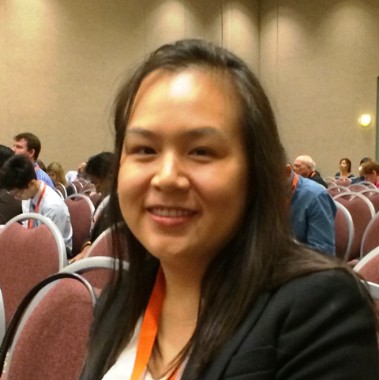User login
MINNEAPOLIS – Increased exposure to ozone appeared to increase cardiorespiratory events in healthy sleeping infants, based on preliminary data.
Dr. Chana I.C. Chin, a pediatric pulmonology fellow at the Children’s Hospital Los Angeles, and her associates found that for each 10-part-per-billion (ppb) elevation in ozone, there was a 22% higher risk of an apneic or bradycardic event (P = .0012), after adjustment for seasonality, weekday, and individual random effects.
"Air pollution likely increases infant mortality and likely impacts infants to a greater degree than adults," said Dr. Chin. "Infants have small body mass ratio, narrower airways, higher particulate deposition rates, greater volume of air breathed per body weight, and underdeveloped defense mechanisms."
"Infant sleep offers a great way to study the impact of air pollutants. And [infants] sleep 16-18 hours a day and depend on healthy sleep for appropriate growth and development," she added.
Disturbed sleep has been seen in rats exposed to ozone (O3), but human data are scant. Dr. Chin and her associates studied the association between air pollution and sleep-associated cardiopulmonary events in the hopes of elucidating a novel pathway linking early-life exposure to adverse health effects in childhood.
Researchers studied 196 healthy term infants, preterm infants, siblings of SIDS infants, and infants experiencing apparent life-threatening events who were residing in Southern California and recruited in 1994-1998 for the Collaborative Home Infant Monitoring Evaluation Study (CHIME). Home-based monitoring of sleep measured central, obstructive, and mixed apnea and bradycardia aggregated over a 24-hour period.
About 60% of the cohort were preterm, with an overall median gestational age of 33.7 weeks. Historical Environmental Protection Agency air quality data on daily O3, nitrogen dioxide, and particulate matter exposure was assigned to each residential zip code.
A greater adverse effect for ozone was found in the term babies (odds ratio, 1.35), compared with the preterm babies (OR, 1.01; P=.0005 for between-group difference), Dr. Chin reported at the annual meeting of the Associated Professional Sleep Societies.
Nitrogen dioxide and particulate matter exposure were not significantly associated with sleep apnea or bradycardia in these infants.
"We speculate that the observed O3 apnea and bradycardia association implies a possible mechanistic pathway for subsequent adverse morbidity and mortality and merits further investigation," Dr. Chin said.
In response to a query on the relative age of the data (1994-1998), she commented that the CHIME data are so valuable since "we don’t really monitor healthy infants anymore."
"There’s no large trial now where a parent would say, "Yes, put my infant on an apnea monitor when there’s no indication," Dr. Chin added.
This study was supported by a pilot project grant from the National Institute of Environmental Health Sciences–funded USC/UCLA Southern Environmental Health Sciences Center and a seed grant from the American Medical Association. Dr. Chin reported having no disclosures.
MINNEAPOLIS – Increased exposure to ozone appeared to increase cardiorespiratory events in healthy sleeping infants, based on preliminary data.
Dr. Chana I.C. Chin, a pediatric pulmonology fellow at the Children’s Hospital Los Angeles, and her associates found that for each 10-part-per-billion (ppb) elevation in ozone, there was a 22% higher risk of an apneic or bradycardic event (P = .0012), after adjustment for seasonality, weekday, and individual random effects.
"Air pollution likely increases infant mortality and likely impacts infants to a greater degree than adults," said Dr. Chin. "Infants have small body mass ratio, narrower airways, higher particulate deposition rates, greater volume of air breathed per body weight, and underdeveloped defense mechanisms."
"Infant sleep offers a great way to study the impact of air pollutants. And [infants] sleep 16-18 hours a day and depend on healthy sleep for appropriate growth and development," she added.
Disturbed sleep has been seen in rats exposed to ozone (O3), but human data are scant. Dr. Chin and her associates studied the association between air pollution and sleep-associated cardiopulmonary events in the hopes of elucidating a novel pathway linking early-life exposure to adverse health effects in childhood.
Researchers studied 196 healthy term infants, preterm infants, siblings of SIDS infants, and infants experiencing apparent life-threatening events who were residing in Southern California and recruited in 1994-1998 for the Collaborative Home Infant Monitoring Evaluation Study (CHIME). Home-based monitoring of sleep measured central, obstructive, and mixed apnea and bradycardia aggregated over a 24-hour period.
About 60% of the cohort were preterm, with an overall median gestational age of 33.7 weeks. Historical Environmental Protection Agency air quality data on daily O3, nitrogen dioxide, and particulate matter exposure was assigned to each residential zip code.
A greater adverse effect for ozone was found in the term babies (odds ratio, 1.35), compared with the preterm babies (OR, 1.01; P=.0005 for between-group difference), Dr. Chin reported at the annual meeting of the Associated Professional Sleep Societies.
Nitrogen dioxide and particulate matter exposure were not significantly associated with sleep apnea or bradycardia in these infants.
"We speculate that the observed O3 apnea and bradycardia association implies a possible mechanistic pathway for subsequent adverse morbidity and mortality and merits further investigation," Dr. Chin said.
In response to a query on the relative age of the data (1994-1998), she commented that the CHIME data are so valuable since "we don’t really monitor healthy infants anymore."
"There’s no large trial now where a parent would say, "Yes, put my infant on an apnea monitor when there’s no indication," Dr. Chin added.
This study was supported by a pilot project grant from the National Institute of Environmental Health Sciences–funded USC/UCLA Southern Environmental Health Sciences Center and a seed grant from the American Medical Association. Dr. Chin reported having no disclosures.
MINNEAPOLIS – Increased exposure to ozone appeared to increase cardiorespiratory events in healthy sleeping infants, based on preliminary data.
Dr. Chana I.C. Chin, a pediatric pulmonology fellow at the Children’s Hospital Los Angeles, and her associates found that for each 10-part-per-billion (ppb) elevation in ozone, there was a 22% higher risk of an apneic or bradycardic event (P = .0012), after adjustment for seasonality, weekday, and individual random effects.
"Air pollution likely increases infant mortality and likely impacts infants to a greater degree than adults," said Dr. Chin. "Infants have small body mass ratio, narrower airways, higher particulate deposition rates, greater volume of air breathed per body weight, and underdeveloped defense mechanisms."
"Infant sleep offers a great way to study the impact of air pollutants. And [infants] sleep 16-18 hours a day and depend on healthy sleep for appropriate growth and development," she added.
Disturbed sleep has been seen in rats exposed to ozone (O3), but human data are scant. Dr. Chin and her associates studied the association between air pollution and sleep-associated cardiopulmonary events in the hopes of elucidating a novel pathway linking early-life exposure to adverse health effects in childhood.
Researchers studied 196 healthy term infants, preterm infants, siblings of SIDS infants, and infants experiencing apparent life-threatening events who were residing in Southern California and recruited in 1994-1998 for the Collaborative Home Infant Monitoring Evaluation Study (CHIME). Home-based monitoring of sleep measured central, obstructive, and mixed apnea and bradycardia aggregated over a 24-hour period.
About 60% of the cohort were preterm, with an overall median gestational age of 33.7 weeks. Historical Environmental Protection Agency air quality data on daily O3, nitrogen dioxide, and particulate matter exposure was assigned to each residential zip code.
A greater adverse effect for ozone was found in the term babies (odds ratio, 1.35), compared with the preterm babies (OR, 1.01; P=.0005 for between-group difference), Dr. Chin reported at the annual meeting of the Associated Professional Sleep Societies.
Nitrogen dioxide and particulate matter exposure were not significantly associated with sleep apnea or bradycardia in these infants.
"We speculate that the observed O3 apnea and bradycardia association implies a possible mechanistic pathway for subsequent adverse morbidity and mortality and merits further investigation," Dr. Chin said.
In response to a query on the relative age of the data (1994-1998), she commented that the CHIME data are so valuable since "we don’t really monitor healthy infants anymore."
"There’s no large trial now where a parent would say, "Yes, put my infant on an apnea monitor when there’s no indication," Dr. Chin added.
This study was supported by a pilot project grant from the National Institute of Environmental Health Sciences–funded USC/UCLA Southern Environmental Health Sciences Center and a seed grant from the American Medical Association. Dr. Chin reported having no disclosures.
AT SLEEP 2014
Key clinical point: Apnea was more frequent in even healthy babies when ozone was high.
Major finding: In healthy sleeping infants, for every 10-ppb elevation in ozone, a 22% increase was seen in apnea and bradycardia events.
Data source: 205 infants residing in Southern California and recruited in the 1994-1998 for the Collaborative Home Infant Monitoring Evaluation Study.
Disclosures: The study was supported by a pilot project grant from the National Institute of Environmental Health Science–funded USC/UCLA Southern Environmental Health Sciences Center and a seed grant from the American Medical Association. Dr. Chin reported having no disclosures.

